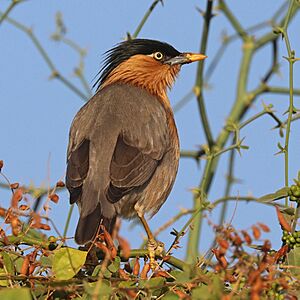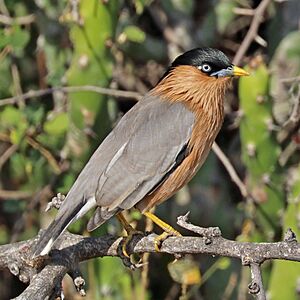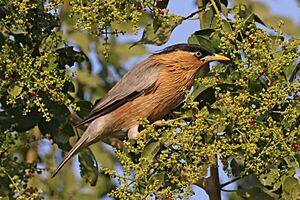Brahminy starling facts for kids
Quick facts for kids Brahminy starling |
|
|---|---|
 |
|
| Male | |
 |
|
| Female Both in Rajasthan, India |
|
| Conservation status | |
| Scientific classification | |
| Genus: |
Sturnia
|
| Species: |
pagodarum
|
| Synonyms | |
|
Sturnus pagodarum |
|
The Brahminy Starling, also known as the Brahminy Myna, is a beautiful bird from the starling family. Its scientific name is Sturnia pagodarum. You can often see these birds in pairs or small groups. They live in open areas across the plains of the Indian subcontinent.
Contents
About Its Name
The Brahminy Starling got its official name in 1789. A German scientist named Johann Friedrich Gmelin first described it. He called it Turdus pagodarum at first. The name pagodarum means "of the temples" or "of the pagodas" in Latin. This is because the bird was often seen near buildings and temples in southern India.
Later, scientists studied these birds more closely. They decided to move the Brahminy Starling to a different group, or genus, called Sturnia. This group was first named by René Lesson in 1837. Today, the Brahminy Starling is the only type of its kind. This means it doesn't have any subspecies.
What It Looks Like

This myna bird is a pale creamy color. It has a black cap on its head and a loose crest of feathers. Its beak is yellow with a bluish color at the base. The bird's eyes are pale, and there is a blue patch of skin around them.
The outer feathers of its tail are white. The main flight feathers on its wings are black and do not have white patches. Male Brahminy Starlings have a crest that stands out more than the female's. They also have longer feathers on their neck. Young birds are not as brightly colored, and their cap is more brownish.
Where It Lives
The Brahminy Starling lives all year round in Nepal and India. It visits Sri Lanka during the winter months. In parts of the western and northeastern Himalayas, it comes for the summer. You can also spot these birds in the plains of Pakistan.
They usually live in dry forests, scrub jungles, and farmlands. These birds are often found close to where people live. They especially like areas with wet or marshy lands. While mostly seen on plains, some have been recorded high up. A few have been seen above 3,000 meters in places like Ladakh.
How It Behaves
What It Eats
Like most starlings, the Brahminy Starling eats many different things. It enjoys both fruits and insects. These birds have even been seen eating fruits from the Thevetia peruviana plant. These fruits are poisonous to many other animals.
Brahminy Starlings often form small groups. They mix with other myna birds on grassy ground. Sometimes, they look for food next to cows that are grazing. They also visit flowers to drink nectar. They especially like flowers from Salmalia, Butea monosperma, and Erythrina trees. At night, many of them gather to sleep together in leafy trees. They often share these roosting spots with parakeets and other mynas.
How It Raises Young
The Brahminy Starling builds its nest inside holes in trees or other hollow spaces. Their breeding season usually runs from March to September. The exact timing can change depending on where they live. In southern India, it starts earlier. The breeding season happens when many plants are producing fruit. This means the young birds hatch just as the rains begin.
The male bird chooses the nest spot. Sometimes, he has to compete with other birds that also nest in holes. Both the male and female help build the nest. They line it with grass, feathers, and pieces of cloth. A female usually lays three to four eggs. These eggs are a pale bluish-green color.
The female bird sits on the eggs to keep them warm, mostly at night. The male helps for short times during the day. The eggs hatch in about 12 to 14 days. The young birds are ready to leave the nest when they are about three weeks old. Parents feed the young insects at first. Later, they give them grains. After feeding, the parents wait for the young to get rid of waste. They carefully remove it and drop it far from the nest. A pair of Brahminy Starlings can raise two or three groups of young birds in one season.


